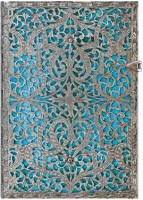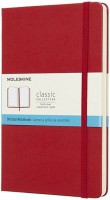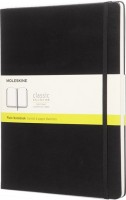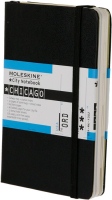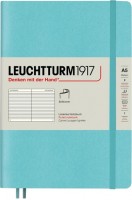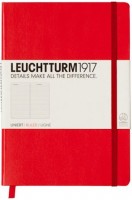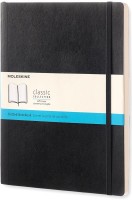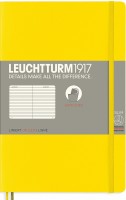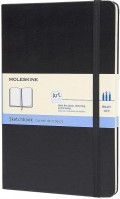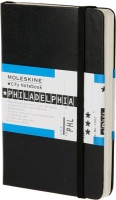Notebooks Leuchtturm1917
All Notebooks Advanced filters → |
You might be interested in
Notebooks: specifications, types
Set of Notebooks
The availability of more than one notebook in the package. Usually, the products in the set are similar in all main specs and differ only in the colour of the cover. If you need several notebooks of the same type (for example, for notes on several parallel projects), a set can be very useful: you will get a guaranteed number of notebooks, and it can also be cheaper than buying out of a set.
Paper size
The format determines the size of the sheet in the notebook and, accordingly, its dimensions in length and width. Here, the standard clerical designation with letter "A" with a number is traditionally used. Nowadays, there are such options:
— A3. The largest of the formats used in modern notebooks: A3 sheet size is 420x297, or twice the A4 (see below). Such products usually do not have a leaflet (see below) and are more like sketchbooks than notebooks in the regular sense of the word; accordingly, they are intended mainly for artists.
— A4. A format known as the "standard landscape sheet"; the actual dimensions are 297x210. Despite the general popularity, it is quite rare among notebooks: a product of such dimensions is not compact, and it is not very convenient to carry. Such notebooks are designed primarily for those who need "space" for notes or sketches.
— A5. Such a sheet is half the size of A4, its dimensions are 210x148 mm. It is one of the most common in modern notebooks, as it offers a good compromise between compactness and space for writing/drawings.
— A6. A sheet corresponding in size to a quarter of a landscape (A4) — its dimensions are 148x105 mm, which is comparable to a standard photo and makes it easy to carry a notebook in your pocket. At the same time, there is not much space on t...he sheet, respectively. It is worth paying attention to such products if compactness and ease of carrying play a decisive role.
— A7. The most compact of the formats found in modern notebooks is half the size of an A6 sheet, 105x74 mm in size. Such a sheet is very tiny and requires saving space while recording; on the other hand, an A7 notebook will fit in almost any pocket without any problems.
Note that it is not about exact compliance with the formats — usually, the actual dimensions of the notebooks may differ slightly from the accepted standard. However, in general, this parameter quite allows you to navigate in size.
— A3. The largest of the formats used in modern notebooks: A3 sheet size is 420x297, or twice the A4 (see below). Such products usually do not have a leaflet (see below) and are more like sketchbooks than notebooks in the regular sense of the word; accordingly, they are intended mainly for artists.
— A4. A format known as the "standard landscape sheet"; the actual dimensions are 297x210. Despite the general popularity, it is quite rare among notebooks: a product of such dimensions is not compact, and it is not very convenient to carry. Such notebooks are designed primarily for those who need "space" for notes or sketches.
— A5. Such a sheet is half the size of A4, its dimensions are 210x148 mm. It is one of the most common in modern notebooks, as it offers a good compromise between compactness and space for writing/drawings.
— A6. A sheet corresponding in size to a quarter of a landscape (A4) — its dimensions are 148x105 mm, which is comparable to a standard photo and makes it easy to carry a notebook in your pocket. At the same time, there is not much space on t...he sheet, respectively. It is worth paying attention to such products if compactness and ease of carrying play a decisive role.
— A7. The most compact of the formats found in modern notebooks is half the size of an A6 sheet, 105x74 mm in size. Such a sheet is very tiny and requires saving space while recording; on the other hand, an A7 notebook will fit in almost any pocket without any problems.
Note that it is not about exact compliance with the formats — usually, the actual dimensions of the notebooks may differ slightly from the accepted standard. However, in general, this parameter quite allows you to navigate in size.
Page Design
Ruler refers to the layout of the pages of a notebook. It differs depending on the purpose.
— Plain. Plain notebooks have blank pages. This is useful primarily for free sketches and other works of fine art, where extra elements only get worse.
— Grid. Notebooks with a grid layout, like school notebooks. Well suited for working with numerical information, solving mathematical exercises, creating tables, drawing graphs and charts.
— Ruled. Ruled notebooks will be useful for operating with textual information — from key moments at a meeting or press conference to poems and prose of your own composition, sudden ideas, etc.
— Dot grid. The dots with this layout are arranged so that they form squares that imitate a grid. Something similar happens if, on a page with a grid of lines, put a dot at each intersection of the lines, and then somehow remove the lines, leaving only dots. These notebooks are indispensable for technical projects where you often have to deal with straight lines and angles: dots provide a very convenient base for drawing. At the same time, the finished drawing has a minimum of unnecessary elements, because many (if not all) of the points end up covered by the pattern.
— Combined. Notebooks consisting of several parts with different types of...layout: for example, one half is folded from blank sheets, and the second is marked with a ruler. This provides versatility: one notebook can be used for different purposes.
— Hobby. Layout optimized for use in a specific area of human activity. These products include notebooks for storing recipes, cataloging books or films, records of food and drink tastings, options for dog lovers, cats, other pets, for adherents of a healthy lifestyle, and much more. Usually, models with a “hobby” layout have several specialized sections, and the variety of markup even in one notebook is very large.
— Plain. Plain notebooks have blank pages. This is useful primarily for free sketches and other works of fine art, where extra elements only get worse.
— Grid. Notebooks with a grid layout, like school notebooks. Well suited for working with numerical information, solving mathematical exercises, creating tables, drawing graphs and charts.
— Ruled. Ruled notebooks will be useful for operating with textual information — from key moments at a meeting or press conference to poems and prose of your own composition, sudden ideas, etc.
— Dot grid. The dots with this layout are arranged so that they form squares that imitate a grid. Something similar happens if, on a page with a grid of lines, put a dot at each intersection of the lines, and then somehow remove the lines, leaving only dots. These notebooks are indispensable for technical projects where you often have to deal with straight lines and angles: dots provide a very convenient base for drawing. At the same time, the finished drawing has a minimum of unnecessary elements, because many (if not all) of the points end up covered by the pattern.
— Combined. Notebooks consisting of several parts with different types of...layout: for example, one half is folded from blank sheets, and the second is marked with a ruler. This provides versatility: one notebook can be used for different purposes.
— Hobby. Layout optimized for use in a specific area of human activity. These products include notebooks for storing recipes, cataloging books or films, records of food and drink tastings, options for dog lovers, cats, other pets, for adherents of a healthy lifestyle, and much more. Usually, models with a “hobby” layout have several specialized sections, and the variety of markup even in one notebook is very large.
Paper grammage
The grammage of the paper used in the notebook primarily depends on its thickness and durability. In addition, this parameter often determines the quality in general: thick paper usually belongs to a higher price range than lighter paper. For comparison, it can be noted that the thinnest packaging paper has a grammage of about 20 g/m², the density of a standard “office” paper is 80 g/m², and 150 g/m² material is already referred to as cardboard.
Keep in mind that a more grammage and, accordingly, thicker paper correspondingly increases the thickness of the product (ceteris paribus).
Keep in mind that a more grammage and, accordingly, thicker paper correspondingly increases the thickness of the product (ceteris paribus).
Binding
The type of binding (cover) used in the notebook.
— Soft. In this case, it means that such a binding is able to bend quite strongly and straighten again without visible traces. This is one of the main advantages of such covers: for example, when tightly packed in a bag, a notebook can easily fit the environment, bending to the desired shape. Of course, the flexibility of bindings is not infinite, and the degree of protection they provide is generally somewhat lower than that of hardcovers. However, this degree is sufficient in most cases, and this type of notebook cover is by far the most common. They can be made from almost any material (see below), except for metal.
— Hard. Hard covers that do not lend to any serious bending without damage. Such covers are usually thicker than soft ones and better protect the contents of the notebook from various adverse effects. At the same time, they are less convenient, and therefore have not received significant retail spread. The most commonly used material for hardcovers is cardboard.
— Spiral. This category includes notebooks where the pages are bound with a characteristic spiral wire threaded through the holes on each sheet. The main advantage of such bindings can be called the ability to easily tear out any page (whereas other types of bindings use paper clips or stitching with thread, and this i...s not so easy to do).
— Soft. In this case, it means that such a binding is able to bend quite strongly and straighten again without visible traces. This is one of the main advantages of such covers: for example, when tightly packed in a bag, a notebook can easily fit the environment, bending to the desired shape. Of course, the flexibility of bindings is not infinite, and the degree of protection they provide is generally somewhat lower than that of hardcovers. However, this degree is sufficient in most cases, and this type of notebook cover is by far the most common. They can be made from almost any material (see below), except for metal.
— Hard. Hard covers that do not lend to any serious bending without damage. Such covers are usually thicker than soft ones and better protect the contents of the notebook from various adverse effects. At the same time, they are less convenient, and therefore have not received significant retail spread. The most commonly used material for hardcovers is cardboard.
— Spiral. This category includes notebooks where the pages are bound with a characteristic spiral wire threaded through the holes on each sheet. The main advantage of such bindings can be called the ability to easily tear out any page (whereas other types of bindings use paper clips or stitching with thread, and this i...s not so easy to do).
Cover material
— Cardboard. A kind of paper that differs from the regular paper in greater thickness and, accordingly, rigidity. The main advantages of cardboard are ease of production and low cost. At the same time, its protective properties are quite modest: for example, water resistance is usually out of view, and stains from various liquids (for example, tea) instantly appear on such a cover. In addition, after bending, a characteristic wrinkle remains on the straightened cardboard, spoiling the appearance. As a result, this material is used relatively rarely and mainly in the simplest versions of notebooks.
— Leather. A very advanced material that combines good protective properties and stylish appearance — thanks to that, a leather notebook can also play the role of a fashion accessory. Leather covers are available in various colours and textures (smooth leather, suede). As for the protective properties, it is worth mentioning water resistance and temperature extremes. At the same time, this material is sensitive to scratches and rather demanding to care for: you need to occasionally treat it with protective agents and follow special conditions for cleaning and drying. If not, deformations and cracks are possible, spoiling the appearance of the product. And the cost of the skin is quite high.
— Ecopolymer. In terms of practical specs, this material is a type of plastic; the word "eco" in the name indicates the safety for the env...ironment claimed by the manufacturer. The ecopolymer is durable enough, moisture resistant, easily cleaned of dirt, it can be given almost any colour, and this material is inexpensive. Among the cons can be noted the predisposition to scratches.
— Metal. If we talk about notebook covers, then metal can be attributed to exclusive materials. It is durable, resistant to moisture, temperature extremes and dirt, practically does not bend, while giving the product a stylish original appearance. At the same time, the use of such notebooks is associated with a number of inconveniences. For example, the edge of the cover, if handled carelessly, can easily scratch the furniture, and the cover itself often creates unnecessary noise (this is especially unpleasant on glass surfaces). Because of this some other reasons, this option is very rare.
— Leather. A very advanced material that combines good protective properties and stylish appearance — thanks to that, a leather notebook can also play the role of a fashion accessory. Leather covers are available in various colours and textures (smooth leather, suede). As for the protective properties, it is worth mentioning water resistance and temperature extremes. At the same time, this material is sensitive to scratches and rather demanding to care for: you need to occasionally treat it with protective agents and follow special conditions for cleaning and drying. If not, deformations and cracks are possible, spoiling the appearance of the product. And the cost of the skin is quite high.
— Ecopolymer. In terms of practical specs, this material is a type of plastic; the word "eco" in the name indicates the safety for the env...ironment claimed by the manufacturer. The ecopolymer is durable enough, moisture resistant, easily cleaned of dirt, it can be given almost any colour, and this material is inexpensive. Among the cons can be noted the predisposition to scratches.
— Metal. If we talk about notebook covers, then metal can be attributed to exclusive materials. It is durable, resistant to moisture, temperature extremes and dirt, practically does not bend, while giving the product a stylish original appearance. At the same time, the use of such notebooks is associated with a number of inconveniences. For example, the edge of the cover, if handled carelessly, can easily scratch the furniture, and the cover itself often creates unnecessary noise (this is especially unpleasant on glass surfaces). Because of this some other reasons, this option is very rare.
Clasp/elastic band
The presence of a clasp or elastic band in the design of the notebook, that holds the cover, preventing it from opening being closed. This feature prevents accidental opening (for example, inside a bag or when dropped) that could cause pages to be wrinkled, dirty or damaged, etc.
Pockets
The availability of own pockets, located, usually, from inside the cover of the diary. Of course, you can’t put a large item into such a pocket, but they can be very useful for business cards, individual sheets of notes, etc.

